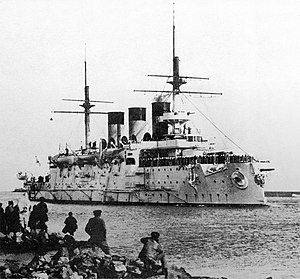Russian battleship Oslyabya

Oslyabya leaving Bizerte, Tunisia, 1903
|
|
| History | |
|---|---|
|
|
|
| Name: | Oslyabya |
| Namesake: | Rodion Oslyabya |
| Builder: | New Admiralty Shipyard, Saint Petersburg |
| Cost: | 11,340,000 rubles |
| Laid down: | 21 November 1895 |
| Launched: | 8 November 1898 |
| In service: | 1903 |
| Fate: | Sunk at the Battle of Tsushima, 27 May 1905 |
| General characteristics | |
| Class and type: | Peresvet-class pre-dreadnought battleship |
| Displacement: | 14,408 long tons (14,639 t) |
| Length: | 434 ft 5 in (132.4 m) |
| Beam: | 71 ft 6 in (21.8 m) |
| Draft: | 26 ft 3 in (8.0 m) |
| Installed power: |
|
| Propulsion: | 3 shafts, 3 Vertical triple-expansion steam engines |
| Speed: | 18 knots (33 km/h; 21 mph) |
| Range: | 6,200 nmi (11,500 km; 7,100 mi) at 10 knots (19 km/h; 12 mph) |
| Complement: | 27 officers, 744 enlisted men |
| Armament: |
|
| Armor: | |
Oslyabya (Russian: Ослябя) was the second of the three Peresvet-class second-class pre-dreadnought battleships built for the Imperial Russian Navy at the end of the nineteenth century, although construction delays meant that she was the last to be completed. The ship was part of the Second Pacific Squadron sent to the Far East during the Russo-Japanese War of 1904–05, and served as the flagship of Rear Admiral Baron Dmitry von Fölkersam. Oslyabya was sunk on 27 May 1905 at the Battle of Tsushima, and was the first all-steel battleship to be sunk by naval gunfire alone. Sources differ on the exact number of casualties, but over half her crew went down with the ship.
The design of the Peresvet class was inspired by the British second-class battleships of the Centurion class. The British ships were intended to defeat commerce-raiders like the Russian armored cruisers Rossia and Rurik; the Peresvet-class ships were designed to support the Russian cruisers. This role placed a premium on high speed and long range at the expense of heavy armament and armor.
Oslyabya had a length of 434 feet 5 inches (132.4 m) overall, a beam of 71 feet 6 inches (21.79 m) and a draft of 26 feet 3 inches (8.0 m). Designed to displace 12,674 long tons (12,877 t), she was almost 2,000 long tons (2,000 t) overweight and displaced 14,408 long tons (14,639 t) when built. Her crew consisted of 27 officers and 744 enlisted men. The ship was powered by three vertical triple-expansion steam engines using steam generated by 30 Belleville boilers. The engines were rated at 14,500 indicated horsepower (10,800 kW), using forced draft, and designed to reach a top speed of 18 knots (33 km/h; 21 mph). Oslyabya, however, reached a top speed of 18.33 knots (33.95 km/h; 21.09 mph) from 15,051 indicated horsepower (11,224 kW) during her sea trials in September 1902. She carried a maximum of 2,060 long tons (2,090 t) of coal which allowed her to steam for 6,200 nautical miles (11,500 km; 7,100 mi) at a speed of 10 knots (19 km/h; 12 mph).
...
Wikipedia
